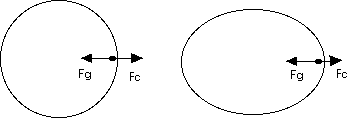A spinning koosh™ like a spinning planet has an equatorial bulge

A spinning koosh™ like a spinning planet has an equatorial bulge

Introduction
A Koosh™ ball is a ball made from strands of rubber. The outer parts of the ball are soft and easily deformed. When the ball is spun and tossed into the air it bulges around its equator like a spinning planet.
Material
A Koosh™ ball, the larger the better.
To Do and Notice
Gently toss a Koosh™ ball into the air.
Notice that it is spherical.
Have a partner spin the Koosh™ while they throw it into the
air,
or do it yourself while watching in a mirror.
Notice that the Koosh™ bulges out around the equator and
flattens at the poles.
To spin the Koosh™ hold it near the tips of the fingers of one
hand and then spin your fingers as you throw the Koosh™ in the
air.
You may also hold onto a few of the elastic threads of the ball with one hand while you give it a spin with the other. Or even grab the threads from the ball in a drill and use the drill to spin the Koosh™.
What’s Going On
The earth rotates and has a shape close to what would be predicted for a rotating liquid held together by its own gravity. The distance from the center to an average point on the equator is about 1/297 greater than the distance from the center to the poles. This means that, while the earth looks spherical to a human observer it is really an ellipsoid of revolution.
Molecules attract each other when far apart, and repel each other when close together, they behave almost as if they were connected by springs. A non-rotating planet pulled together by the attraction of gravity collapses until the repulsive forces between molecules, Fc, balance the inward pull of gravity, Fg. In equilibrium, there will be no net force on any molecule. Such a planet will be a sphere.

A mass located at the equator of a rotating planet moves in a circle. When an object moves in a circle it accelerates toward the center of the circle, this requires a net force. The force of gravity, Fg, on the mass remains almost the same. The net force is the result of a deceased contact force, i.e. Fc is less. The decreased repulsion comes about because the molecules move slightly further apart, resulting in an equatorial bulge. (Like a rubber rod which has been compressed by gravity, but is now less compressed.
Etc
Scientists from England and France once argued over the shape of the earth. Newton predicted that the earth would bulge outward around its equator and be flattened at the poles while Cassini predicted that the earth would bulge at the poles. To resolve the conflict, expeditions travelled to high latitudes and to equatorial latitudes on the earth. The data they brought back showed that Newton was correct and that the earth had an equatorial bulge.
|
Scientific Explorations with Paul Doherty |
|
12 July 2001 |